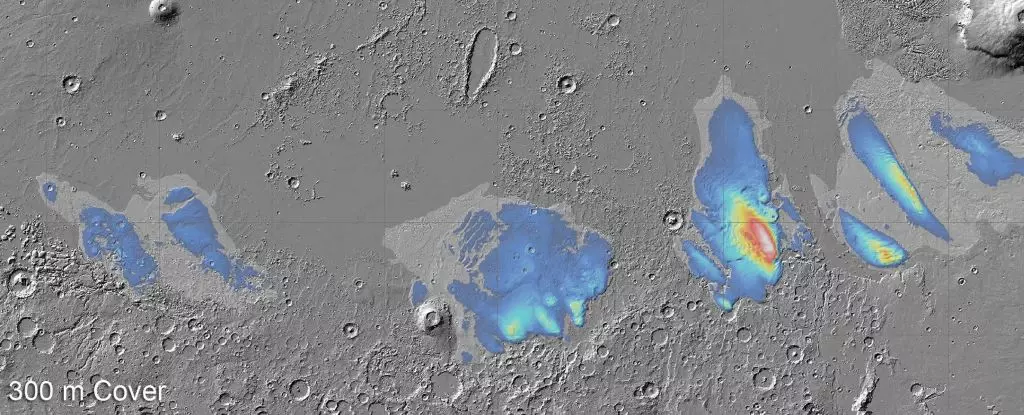The surface of Mars has long been regarded as barren and devoid of water, but recent discoveries have challenged this notion. A groundbreaking radar survey of the Medusae Fossae Formation region on the Martian equator has revealed the presence of giant layered slabs of buried water ice, surpassing any previous findings. These ice deposits, several kilometers thick, indicate that Mars may not be as dry as previously thought, with enough water buried there to cover the planet in a shallow ocean. The newfound information raises questions about the history and potential habitability of the red planet.
Scientists initially detected hints of the buried deposits in 2007 up to a depth of 2.5 kilometers (1.6 miles). However, new data gathered from Mars Express’s MARSIS radar and improved analysis tools have revealed that the deposits are even thicker than anticipated. Geologist Thomas Watters of the Smithsonian Institution remarks, “We’ve explored the Medusae Fossae Formation again using newer data and found the deposits to be even thicker than we thought: up to 3.7 kilometers (2.3 miles) thick.” This depth of ice indicates a significant water presence and interesting similarities to Mars’s polar caps, which are known to be rich in ice.
The Medusae Fossae Formation stretches for approximately 5,000 kilometers (3,107 miles) along Mars’ equator, marking the boundary between its lowlands and cratered highlands. While the origins of these formations remain unknown, their immense size and prominence make them a captivating subject of study. Sculpted by the fierce winds on Mars, these deposits stand several kilometers high, adding to the intrigue surrounding this region. With limited understanding of the Medusae Fossae Formation, scientists are motivated to uncover more about its secrets.
In 2007, Thomas Watters and his team detected radar signals that indicated the presence of something buried beneath the Martian surface. The true nature of these buried objects remained unclear and could have consisted of dust, volcanic material, sediment, or, intriguingly, water ice. To investigate further, researchers collected additional radar observations, analyzed the results, and conducted modeling experiments to determine the composition of the buried deposits. Water ice emerged as the most viable explanation, aligning with the data collected. Physicist Andrea Cicchetti of the National Institute for Astrophysics in Italy explains, “Given how deep it is, if the Medusae Fossae Formation was simply a giant pile of dust, we’d expect it to become compacted under its own weight. And when we modeled how different ice-free materials would behave, nothing reproduced the properties of the Medusae Fossae Formation – we need ice.”
Our understanding of Mars has transformed significantly in recent decades, as evidence of water on the planet’s surface has emerged. Studies have revealed traces of rivers, lakes, and possibly even oceans that existed in Mars’ ancient history. While liquid water is no longer present, the whereabouts of this essential resource remains a compelling enigma. Did it evaporate into space or become trapped beneath the planet’s surface? The discovery of extensive water deposits within the Medusae Fossae Formation offers a glimmer of hope for uncovering the secrets of Mars’ past. Scientists hope to locate additional water sources on the red planet, as it would be crucial for future human missions where utilization of Martian resources is paramount.
The discovery of abundant water ice within the Medusae Fossae Formation raises hope that similar deposits may exist elsewhere on Mars. This finding holds practical significance for future human missions, as access to water on the planet would reduce the need to transport this vital resource from Earth. Although the water within the formation remains beyond our reach, it offers invaluable insights into the Martian climate and its transformation over time. Planetary scientist Colin Wilson of the European Space Agency reflects, “This latest analysis challenges our understanding of the Medusae Fossae Formation and raises as many questions as answers.” The confirmation of a vast ice deposit would undoubtedly revolutionize our understanding of Mars’ climate history and provide clues to the planet’s past and potential for future human habitation.
The recent discovery of extensive buried water ice deposits within the Medusae Fossae Formation on Mars provides a remarkable glimpse into the hidden secrets of the red planet. These unexpected findings challenge our assumptions about Mars’ aridity and its potential for harboring life. As exploration and research continue to unravel the mysteries of Mars, scientists now have a renewed focus on locating accessible water sources and deciphering the planet’s complex history. It is an exciting time for Martian exploration, holding promise for future discoveries and potential colonization efforts.


Leave a Reply